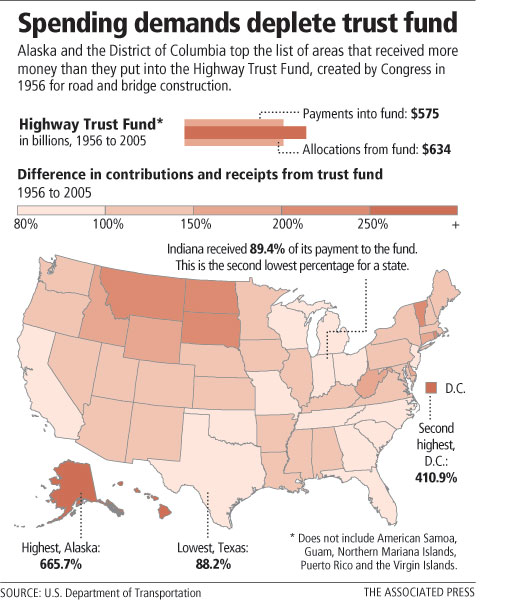Federal highway account dries up

WASHINGTON — A cash crunch is fast approaching for the government trust fund that pays to build and repair highways and bridges.
The federal tax on a gallon of gasoline has not risen in 14 years, and Congress is reluctant to increase it. People are demanding more fuel-efficient vehicles, which means less gasoline used, fewer dollars for the fund.
States already are looking for other places for road-building money such as toll road and consumption-based sales taxes. They worry that the fund’s looming shortage could hurt their efforts to address traffic congestion and environmental and safety problems caused by inadequate roads.
In 2009, revenues for the Federal Highway Trust Fund start falling short of planned federal spending.
The fund provides the overwhelming bulk of federal dollars spent on highways. It gets its money mainly from the 18.4 cents-a-gallon excise tax that drivers pay at the pump.
Self-service regular now tops $3 a gallon. Concern exists that the price will reach a point at which people will get serious about cutting back on driving, sending less money into the fund. Fuel tax receipts dipped last summer when a spike in pump prices occurred.
About 45 percent of all highway spending comes from the trust fund. With less money available from the fund, states must turn elsewhere for money to expand their highways and fill their potholes.
Nevada is a prime example. The Legislature is struggling with what to do about a $3.8 billion shortfall in funding for highway construction. The money is needed for 10 road projects, most of them in Clark County.
But plenty of other states have run into similar problems.
• Indiana, facing a $1.8 billion gap in money needed for road improvements, negotiated a $3.85 billion deal with an Australian-Spanish consortium to lease and operate the Indiana Turnpike for 75 years. Voters expressed their displeasure, electing Democrats to replace a Republican-run House that signed off on the deal.
• In Florida, with federal aid declining, more than 90 percent of new roads since the early 1990s have been toll roads, state Transportation Department spokesman Dick Kane said.
• Voters in Washington state approved a 14.5 cent increase in state gasoline taxes over a five-year period.
• In California, voters decided to borrow the money, approving bond issues totaling $19.9 billion to be used for highway and transit projects over the next 10 years.
• Georgia increased its construction program from $911 million to $2 billion, largely through a sales tax on gasoline that rises with fuel prices, unlike the frozen federal levy.
The American Association of State Highway and Transportation Officials said at least six states have adopted variable fuel taxes that are pegged to inflation.
• Oregon is experimenting with a voluntary system in which drivers pay a user fee based on miles driven rather than gasoline consumed. Some environmentalists contend that the approach negates the benefits of buying fuel-efficient cars.
• Texas, Virginia and Minnesota are among states that have built or are building high-occupancy toll lanes where drivers can pay to have a congestion-free path before them.
Of the 18.4 cents a gallon in federal excise taxes, about 15.44 cents goes to the highway trust fund, 2.86 cents to mass transit programs and one-tenth of a cent to a fund to handle leaking underground storage tanks. The tax on diesel fuel is slightly higher.
Close to two-thirds of the trust fund’s $40 billion in receipts last year came from the gasoline tax.
Gasoline was 30 cents a gallon, and the excise tax on it was 3 cents, when Congress created the Highway Trust Fund in 1956.
As gasoline prices rose, so did the tax. But a tax-adverse Congress has kept it at 18.4 cents a gallon since 1993, when gasoline prices were about $1.10 a gallon.
Two years ago, lawmakers proposed a 4 cent per gallon boost in the fuel tax to pay for a $375 billion highway bill. They backed off when President Bush pledged to veto any road legislation with a tax increase. In the end, the spending plan came to $286 billion.
At the end of 2000, the Highway Trust Fund had a balance of almost $23 billion. By the end of 2006, that balance had fallen to $9 billion.
The Congressional Budget Office predicts the fund will run a deficit of $1.7 billion at the end of 2009 and $8.1 billion by the end of 2010, when the highway program expires and Congress will write a new one.
"This crisis will be thrown in their lap right as they are rewriting the program," said Jeff Shoaf, senior executive director of Associated General Contractors of America.
Because investment in new projects is spread over several years, every dollar of shortfall translates into a $4 drop in highway spending, he said.
In 2010, the government will have only $20 billion to invest on highways, half of the current spending level and less than one-third of the $70 billion that Shoaf said is needed for real road improvements.
"A drastic cut in federal highway and transit funding will result unless Congress steps in," John Horsley, executive director of the American Association of State Highway and Transportation Officials, said in a report.
Horsley’s group said the fuel tax would have to be increased by 10 cents per gallon through 2015 to restore the purchasing power of the program.
By the middle of the next decade, the Highway Trust Fund will be providing $100 billion to $150 billion below real needs for building highways and bridges, predicted Rep. Peter DeFazio, chairman of the House Transportation and Infrastructure subcommittee on highways and transit.
"In the long run we’ve either got to admit we are going to underinvest and accept more gridlock and congestion" or find new revenue sources, said DeFazio, D-Ore.
The Review-Journal contributed to this story.












